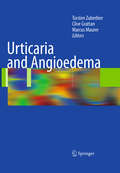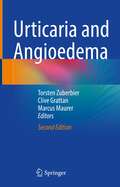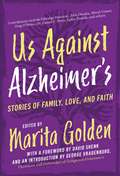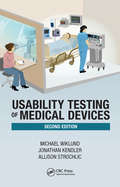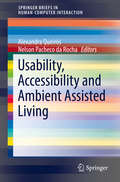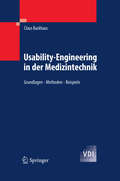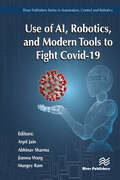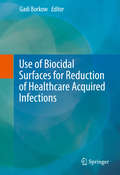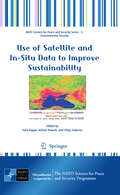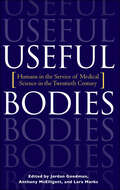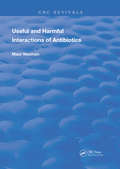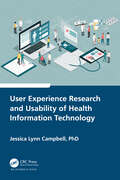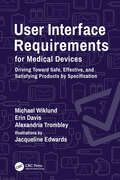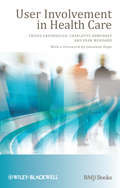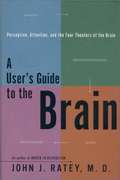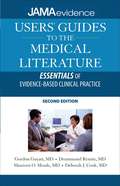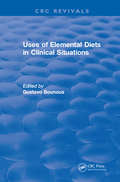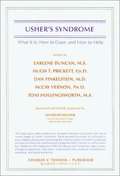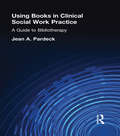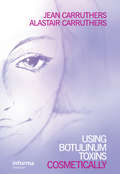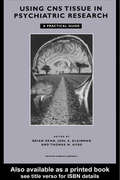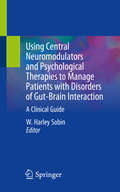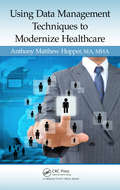- Table View
- List View
Urticaria and Angioedema
by Marcus Maurer Torsten Zuberbier Clive GrattanThis book provides a practical and comprehensive review of all types and aspects of urticaria and angioedema important to the clinician. Its content is completely up-to-date, taking into consideration both current guidelines and all recent literature. This clinical guide highlights current knowledge about pathophysiology, and focuses on the clinically relevant aspects of diagnosis and treatment. It also includes a full range of standard operating procedures, as well as patient information leaflets in a copy-ready format, thus offering invaluable assistance in the daily practical management of urticaria patients. This book provides indispensable assistance to all physicians specializing in dermatology, allergy, internal medicine, pediatrics and general medicine.
Urticaria and Angioedema
by Marcus Maurer Torsten Zuberbier Clive GrattanUrticaria is one of the most common diseases encountered in dermatology. The fleeting nature of wheals often makes a first diagnosis by both patients and physicians seem easy. The disease itself is of a highly complex nature, with a variety of clinical manifestations ranging from pinpoint sized wheals to extensive angioedema. Further complexities include the diversity of possible eliciting and aggravating factors, the many different clinical subtypes and the therapeutic responsiveness.This second, extensively revised edition includes the indications listed in the most recent international guidelines, provides a practical, comprehensive review of all clinical aspects and causes, and addresses the diagnosis and therapy of different types of urticaria. Specific chapters are devoted to classification, aetiopathogenesis, patient reported outcomes, acute urticaria, chronic urticaria and its comorbidities, angioedema without weals, inducible urticarias, special populations including children, treatment with antihistamines and omalizumab, other interventions and looking ahead to new therapies. This new edition is a must read for dermatologists, allergists, pediatricians and practitioners of all disciplines who want their patients to benefit from cutting-edge diagnostics and treatments.
Us Against Alzheimer's: Stories of Family, Love, and Faith
by Marita GoldenThis groundbreaking multicultural anthology shares moving personal stories about the impacts of Alzheimer’s and dementia. An estimated 5.7 million Americans are afflicted by Alzheimer’s disease, including 10 percent of those over sixty-five, and it is the sixth leading cause of death. But its effects are more pervasive: for the nearly 6 million sufferers, there are more than 16 million family caregivers and many more family members. Alzheimer’s wreaks havoc not only on brain cells; it is a disease of the spirit and heart for those who suffer from it but also for their families. This groundbreaking anthology presents forty narratives, both nonfiction and fiction, that together capture the impact and complexity of Alzheimer’s and other dementias on patients as well as their caregivers and family. Deeply personal, recounting the wrenching course of a disease that kills a loved one twice—first they forget who they are, and then the body succumbs—these stories also show how witnessing the disease and caring for someone with it can be powerfully transformative, calling forth amazing strength and grace. The contributors, who have all generously donated their work, include Edwidge Danticat, Julie Otsuka, Elizabeth Nunez, Meryl Comer, Greg O’Brien, Dr. Daniel Potts, Sallie Tisdale, and Nihal Satyadev. Reflecting the diversity and global nature of the dementia crisis, this anthology is published in collaboration with UsAgainstAlzheimer’s.
Usability Testing of Medical Devices
by Michael E. Wiklund P.E. Jonathan Kendler Allison Y. StrochlicUsability Testing of Medical Devices covers the nitty-gritty of usability test planning, conducting, and results reporting. The book also discusses the government regulations and industry standards that motivate many medical device manufacturers to conduct usability tests.Since publication of the first edition, the FDA and other regulatory groups h
Usability, Accessibility and Ambient Assisted Living
by Alexandra Queirós Nelson Pacheco da RochaWorldwide, the population ageing is a reality. The concept of Active Ageing, adopted by the World Health Organization, aims to guarantee quality ageing and appears as a strategy to solve this demographic challenge. The technological solutions might have a key role in the promotion of human functioning and in the mitigation of disabilities, particularly those resulting from the natural ageing process. This perspective is evident in the development of Ambient Assisted Living (AAL) solutions. In this context, it is relevant to know about the recent developments in AAL and discuss future trends and challenges in this area. One of the objectives of this book is to do a systematic literature review on AAL, not only considering the technology used, but also the health condition that is intended to improve. For this purpose, we consider the human functioning, in particular the conceptual model of International Classification of Functioning, Disability and Health (ICF). Considering that the ICF conceptual framework is accepted within the healthcare domain, the use of its concepts and terminologies to promote multidisciplinary approaches for AAL solutions development processes can help to overcome difficulties of communication between users, careers and technological developers. AAL solutions must consider in their development the needs of the person that will use AAL solutions. The development must be user-centred and usability questions cannot be forgotten. In addition, the acceptance of the AAL solutions is closely related to the quality of the systems, so it is necessary to appropriately assess these solutions.
Usability-Engineering in der Medizintechnik
by Claus BackhausErgonomisch gestaltete Medizintechnik führt zu effizienteren Arbeitsabläufen, erhöht die Patientensicherheit und reduziert die Arbeitsbelastung. Das Buch erläutert, wie Medizintechnik an die Bedürfnisse der Nutzer und Anwender angepasst werden kann. Durch das beschriebene Vorgehen ist es möglich, sowohl die Anforderungen der harmonisierten Normen DIN EN 62366 und DIN EN 60601-1-6 umzusetzen als auch neue Lösungsansätze für die Entwicklung innovativer Medizintechnik zu erarbeiten. Die Umsetzung wird anhand ausgewählter Praxisbeispiele erörtert.
Use of AI, Robotics and Modelling tools to fight Covid-19
by Mangey Ram Abhinav Sharma Arpit Jain Jianwu WangThe COVID-19 pandemic has hit the global at a colossal scale. With worldwide reported cases of 5.34 million it has led to severe impact on humanity. Being a highly contagious disease, it has given global health services their most severe challenge. Various countries are fighting to minimize the losses due to the outbreak, however a common trait is enforcing lockdown, which has become the main defence mechanism. Researchers are working around the clock to find a breakthrough in the diagnostics and treatment of the pandemic.AI technology is useful for fast drug development and treatment. In the starting phase of COVID-19 pandemic, the medical fraternity in China diagnosed the virus using computed tomography (CT) and X-ray images due to the limitation of testing kits. Deep learning neural network model have also been used for COVID-19 diagnosis. AI assisted intelligent humanoid robots can be used to reduce the human contact and spread of COVID-19. In Italy robots have been used for measuring blood pressure, oxygen saturation and temperature of patients. Robots have also found applications in disinfecting and sterilizing of public places, COVID-19 testing, food and medicine delivery as well as entertaining patients in hospitals and quarantine centers, thereby reducing the workload of doctors and nurses.Prediction of the spread of virus and providing the guidelines or prevention measures is another AI application in COVID-19. Kaggle and GitHub are the two websites where the real-time data of COVID-19 is aggregated. This includes confirmed cases, active cases, cured cases and deaths in each country. This data set can be used for predicting the active cases across different regions of the world so that appropriate amount of health infrastructure can be made available to these places.
Use of Biocidal Surfaces for Reduction of Healthcare Acquired Infections
by Gadi BorkowThe notion that contaminated environments in hospital settings significantly contribute to the risk of an individual acquiring an infection while hospitalized is continuously gaining recognition by the medical community. There is a clear correlation between the environmental bioburden present in a clinical setting and the risk of patients acquiring an infection. Thus using self-disinfecting surfaces can be a very important adjunct in the fight against nosocomial pathogens. This book reviews the increasing evidence that contaminated non-intrusive soft and hard surfaces located in the clinical surroundings are a source of nosocomial pathogens and focuses on the utility of copper containing materials in reducing bioburden and fighting hospital acquired infections. It also reviews other biocidal surface alternatives and the economics of using biocidal surfaces in a hospital environment. Finally, it discusses the pros and cons of existent disinfection modalities other than biocidal surfaces.
Use of Satellite and In-Situ Data to Improve Sustainability
by Alfred Powell Felix Kogan Oleg FedorovMore than 30-year operational satellite data have already been used for monitoring land, ocean and atmosphere. These applications have contributed to improve sustainable economy, produce healthy environment and enhance human life. The Advanced Research Workshop sponsored by NATO and organized by the USA's National Oceanic and Atmospheric Administration and Ukrainian's Space Agency bring the scientists with the most mature research designed for practical use. The goals were to select those which is used for services today and identify the areas to expand research and services. Scientific and application results of the Workshop presented in this book can be used today in agriculture, forestry, water resources, healthy coastal life and fisheries, climate and land cover change, anthropogenic activities and others. The presented papers provide information on how to use operational satellites and in situ measurements for early detection of large-scale droughts, floods and fires, diagnose crop and pasture annual losses, predict periods with health/unhealthy vegetation based on such climate forcing events as ENSO, monitor air quality and geomagnetic activities, assess land cover trends in responce to global warming etc. The available satellite/ground information and method is currently warn with a lead time sufficient to respond, recover and protect.
Useful Bodies: Humans in the Service of Medical Science in the Twentieth Century
by Jordan Goodman Anthony McElligott Lara MarksThough notoriously associated with Germany, human experimentation in the name of science has been practiced in other countries, as well, both before and after the Nazi era. The use of unwitting or unwilling subjects in experiments designed to test the effects of radiation and disease on the human body emerged at the turn of the twentieth century, when the rise of the modern, coercive state and the professionalization of medical science converged. Useful Bodies explores the intersection of government power and medical knowledge in revealing studies of human experimentation—germ warfare and jaundice tests in Great Britain; radiation, malaria, and hepatitis experiments in the U.S.; and nuclear fallout trials in Australia. These examples of medical abuse illustrate the extent to which living human bodies have been "useful" to democratic states and emphasize the need for intense scrutiny and regulation to prevent future violations.Contributors: Brian Balmer, University College London; Miriam Boleyn-Fitzgerald, University of Wisconsin; Rodney A. Hayward, University of Michigan; Joel D. Howell, University of Michigan; Margaret Humphreys, Duke University; David S. Jones, Massachusetts General Hospital; Robert L. Martensen, Tulane University School of Medicine; Glenn Mitchell, University of Wollongong; Jenny Stanton, London School of Hygiene and Tropical Medicine; Gilbert Whittemore, independent scholar/attorney, Boston
Useful Bodies: Humans in the Service of Medical Science in the Twentieth Century
by Jordan Goodman Anthony McElligott Lara MarksA collection of essays that offers “a significant contribution to our understanding of the role of the state in human subjects research” (Journal of the History of Biology).Though notoriously associated with Germany, human experimentation in the name of science has been practiced in other countries, as well, both before and after the Nazi era. The use of unwitting or unwilling subjects in experiments designed to test the effects of radiation and disease on the human body emerged at the turn of the twentieth century, when the rise of the modern, coercive state and the professionalization of medical science converged. Useful Bodies explores the intersection of government power and medical knowledge in revealing studies of human experimentation—germ warfare and jaundice tests in Great Britain; radiation, malaria, and hepatitis experiments in the U.S.; and nuclear fallout trials in Australia. These examples of medical abuse illustrate the extent to which living human bodies have been “useful” to democratic states and emphasize the need for intense scrutiny and regulation to prevent future violations.Contributors: Brian Balmer, University College London; Miriam Boleyn-Fitzgerald, University of Wisconsin; Rodney A. Hayward, University of Michigan; Joel D. Howell, University of Michigan; Margaret Humphreys, Duke University; David S. Jones, Massachusetts General Hospital; Robert L. Martensen, Tulane University School of Medicine; Glenn Mitchell, University of Wollongong; Jenny Stanton, London School of Hygiene and Tropical Medicine; Gilbert Whittemore, independent scholar/attorney, Boston“Each chapter is a startling case study that examines the nature and degree of the state’s involvement in human experimentation.” —Issues in Law and Medicine“Well written and meticulously researched.” —Journal of the History of Medicine and Allied Sciences
Useful and Harmful Interactions of Antibiotics (Routledge Revivals)
by Maur NeumanFirst published in 1987: This book is intended as a guide for a very large group of practitioners in the medical, pharmaceutical, and biological fields. It will enable them to prescribe and use antibiotics in an improved way.
User Experience Research and Usability of Health Information Technology
by Jessica Lynn CampbellHealth information technology (HIT) is a critical component of the modern healthcare system. Yet to be effective and safely implemented in healthcare organizations and physicians and patients’ lives, it must be usable and useful. User Experience (UX) research is required throughout the full system design lifecycle of HIT products, which involve a user-centered and human- centered approach. This book discusses UX research frameworks, study designs, methods, data-analysis techniques, and a variety of data collection instruments and tools that can be used to conduct UX research in the healthcare space, all of which involve HIT and digital health. This book is for academics and scholars to be used to design studies for graduate dissertation work, in independent research, or as a textbook for UX/usability courses in health informatics or related health information and communication courses. This book is also useful for UX practitioners because it provides guidance on how to design a user research or usability study and focuses on leveraging a mixed- methods approach, including step-by-step by instructions and best practices for conducting: Field studies Interviews Focus groups Diary studies Surveys Heuristic evaluation Cognitive walkthrough Think aloud A plethora of standardized surveys and retrospective questionnaires (SUS, Post-study System Usability Questionnaire (PSSUQ)) are also included. UX researchers and healthcare professionals will gain an understanding of how to design a rigorous, yet feasible study that generates useful insights to inform the design of usable HIT. Everything from consent forms to how many participants to include in a usability study has been covered in this book. The author encourages user-centered design (UCD), mixed-methods, and collaboration amongst interdisciplinary teams. Knowledge from many inter-related disciplines, like psychology, technical communication (TC), and human-computer interaction (HCI), together with experiential knowledge from experts is offered throughout the text.
User Innovation in Healthcare: How Patients and Caregivers React Creatively to Illness (SpringerBriefs in Health Care Management and Economics)
by Francesco SchiavoneThis book explores in depth the phenomenon of user innovation in healthcare. In particular, the book sheds light on patient innovation, whereby patients and/or caregivers proactively develop and diffuse new products and services that provide health and quality of life benefits by addressing gaps in existing market offerings. The aim is to clarify the key characteristics of these innovative processes and to offer practitioners and policymakers tangible bottom-up evidence, solutions, and ideas that will assist in improving health systems, organizations, and practices. A number of important and interesting research questions are addressed, casting light on the types of products and services that tend to be developed by patient innovators, the typical profile of these innovators, the role played by firms, institutions, and health professionals, and the ways in which digital technologies support the dissemination of innovations among patient communities and within the industry. Beyond academic scholars and policymakers, the book will be of high value for students on master’s programs in both medical sciences and business and economics.
User Interface Requirements for Medical Devices: Driving Toward Safe, Effective, and Satisfying Products by Specification
by Erin Davis Michael Wiklund Alexandria TrombleyThis book is a practical guide for individuals responsible for creating products that are safe, effective, usable, and satisfying in the hands of the intended users. The contents are intended to reduce the number of use errors involving medical devices that have led to injuries and deaths. The book presents the strong connection between user interface requirements and risk management for medical devices and instructs readers how to develop specific requirements that are sufficiently comprehensive and detailed to produce good results – a user-friendly product that is likely to be used correctly. The book’s tutorial content is complemented by many real-world examples of user interface requirements, including ones pertaining to an inhaler, automated external defibrillator, medical robot, and mobile app that a patient might use to manage her diabetes. The book is intended for people representing a variety of product development disciplines who have responsibility for producing safe, effective, usable, and satisfying medical devices, including those who are studying or working in human factors engineering, psychology, mechanical engineering, biomedical engineering, systems engineering, software programming, technical writing, industrial design, graphic design, and regulatory affairs.
User Involvement in Health Care
by Frcp Trisha Greenhalgh Charlotte Humphrey Fran Woodard Obe Ma Frcgp DProfHow can the needs and perspective of patients be incorporated in the design and redesign of health services? Health organizations are focusing more and more on patients – and requiring their employees to practise patient focused care. The Modernisation Initiative described in this book explores in three health service areas (kidney, stroke and sexual health services) how patients' and carers' involvement may inform and shape quality improvement work This book guides you through the issues and challenges that teams seeking to involve users in changing health services are likely to face. It offers a wealth of practical knowledge about involving users. Those undertaking similar programmes, whether in primary care or hospital based, will find ideas and examples in this book to inspire and guide them.
User's Guide to the Brain: Perception, Attention, and the Four Theaters of the Brain
by John J. RateyFor the first time ever, discoveries in our understanding of the brain are changing anthropology, linguistics, philosophy, and psychology--indeed, the brain itself may become a catalyst for transforming the very nature of these inquiries. In A User's Guide to the Brain, Dr. John Ratey, best-selling coauthor of Driven to Distraction, explains in lucid detail and with perfect clarity the basic structure and chemistry of the brain: how its systems shape our perceptions, emotions, actions, and reactions; how possession of this knowledge can enable us to more fully understand and improve our lives; and how the brain responds to the guidance of its user. He draws on examples from his own practice, from research, and from everyday life to illuminate aspects of the brain's functioning, among them prenatal and early childhood development; the perceptual systems; the processes of consciousness, memory, emotion, and language; and the social brain. As the best means for explaining the dynamic interactions of the brain, Ratey offers as a metaphor the four "theaters" of exploration: 1) the act of perception; 2) the filters of attention, consciousness, and cognition; 3) the array of options employed by the brain--memory, emotion, language, movement-to transform information into function; and 4) behavior and identity. Ratey succeeds not only in giving us a compelling portrait of the brain's infinite flexibility and unpredictability but also in demonstrating how our very understanding of the brain affects who we are.
Users' Guides to the Medical Literature: Essentials of Evidence-Based Clinical Practice (Second Edition)
by The Evidence-Based Medicine Working Group EditorsEvidence-based medicine involves the careful interpretation of medical studies and its clinical application. And no resource helps you do it better-and faster-than Users' Guides to the Medical Literature: Essentials of Evidence-Based Clinical Practice. This streamlined reference distills the most clinically-relevant coverage from the parent Users' Guide Manual into one highly-focused, portable resource. Praised for its clear explanations of detailed statistical and mathematical principles, The Essentials concisely covers all the basic concepts of evidence-based medicine--everything you need to deliver optimal patient care. It's a perfect at-a-glance source for busy clinicians and students, helping you distinguish between solid medical evidence and poor medical evidence, tailor evidence-based medicine for each patient, and much more. Now in its second edition, this carry-along quick reference is more clinically relevant--and more essential--than ever!
Uses of Elemental Diets in Clinical Situations
by G. BounousThe studies presented in this book demonstrate that a new concept in the management of carious intestinal disorders should be considered, namely, that common nutrients may protect or heal the mucosa by virtue of the particular form and mode in which they are delivered to the intestinal lumen and their availability to the mucosal cells. The substitution of intact protein in the formula by hydrolysate appears to me an important factor.
Usher's Syndrome: What It Is, How to Cope, and How to Help
by Earlene Duncan Hugh T. Prickett Dan Finkelstein Mccay Vernon Toni HollingsworthDescribes what Usher's syndrome is, how it impacts a person's life, and ways to cope with this dual disability.
Using Books in Clinical Social Work Practice: A Guide to Bibliotherapy
by Jean A PardeckUsing Books in Clinical Social Work Practice: A Guide to Bibliotherapy introduces clinical social workers and other helping professionals to bibliotherapy, an innovative approach to helping individuals deal with psychological, social, and developmental problems. Literally meaning “treatment through books,” bibliotherapy actively involves the client in the therapeutic process through the reading of carefully selected and evaluated books. With this guide, the therapy you give will provide information and insight, stimulate discussion, communicate new values and attitudes, create awareness that others have similar problems, and provide solutions to problems. Using Books in Clinical Social Work Practice offers a detailed approach for helping clinicians use bibliotherapy in practice. You’ll discover which types of problems best respond to bibliotherapy and you’ll learn how to select the most effective books to treat those problems. You’ll even find the structure of the book helpful, as it: introduces you to the basics of bibliotherapy provides a detailed examination of the techniques for using books in treatment reviews and analyzes the extensive research that has been conducted on bibliotherapy focuses on the problems most effectively treated with bibliotherapy--divorce and remarriage, dysfunctional families, parenting, adoption and foster care, self-development, serious illness, substance abuse offers an authoritative guide to over 300 books found to work most effectively--including summaries and levels of interest presents conclusions and a summary for the use of books in treatmentAlthough bibliotherapy is a well-established practice technique in other professions, including psychiatry and psychology, social work practitioners have not traditionally used bibliotherapy as part of their practice. Using Books in Clinical Social Work Practice gives today’s helping professional an approach to problem solving that you and your clients will find refreshing and effective.
Using Botulinum Toxins Cosmetically: A Practical Guide
by Jean Carruthers Alastair CarruthersBotox, or Botulinum toxin, has become a household word, not so much for its use as an exciting drug in almost every field of medicine, but as a deadly poison that has been somehow transformed into a softener of facial expression lines. When done correctly, the treatment can be safe, effective, and in comparison to other modalities, involves relativ
Using CNS Autopsy Tissue in Psychiatric Research: A Practical Guide
by Brian Dean Thomas M Hyde Joel E KleinmanEssential for the laboratory, this practical manual presents a wide variety of techniques associated with the use of human CNS tissue obtained at autopsy. The book contains detailed methodologies in discrete chapters written by an expert in the specific field. It also addresses the potential for extending molecular studies in brain tissue obtain
Using Central Neuromodulators and Psychological Therapies to Manage Patients with Disorders of Gut-Brain Interaction: A Clinical Guide
by W. Harley SobinThis guide provides a concise overview of central neuromodulators and psychological therapies, and their use in managing patients with disorders of gut-brain interaction. The text demonstrates how central neuromodulators can help disordered gut function and reviews choices of drugs for different disorders, along with dosages and recommendations on their use. The book also outlines the use of cognitive behavioral therapy and exposure therapy in treating these patients, and presents a tutorial on how internal medicine physicians should approach the use of psychiatric medications.Written by experts in the field, Using Central Neuromodulators and Psychological Therapies to Manage Patients with Disorders of Gut-Brain Interaction: A Clinical Guide is a valuable resource for clinicians and practitioners on how to treat and manage patients afflicted with disorders of gut-brain interaction.
Using Data Management Techniques to Modernize Healthcare
by MA, MHA, HopperHealthcare organizations with sound human resources (HR) infrastructures are better able to hire, develop, promote, and retain employees who match up well with their specific needs. Using Data Management Techniques to Modernize Healthcare explains how to modernize your HR systems through the use of artificial intelligence (AI), information technolo
